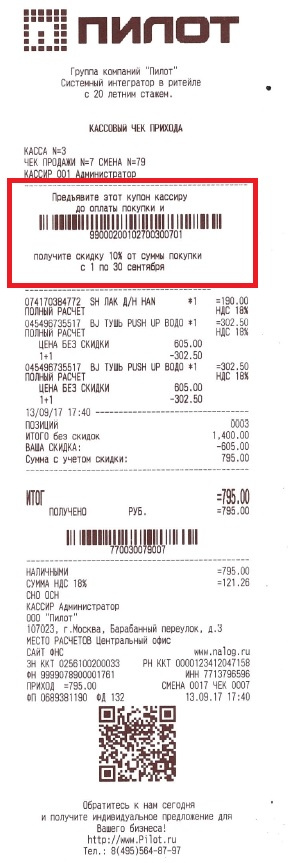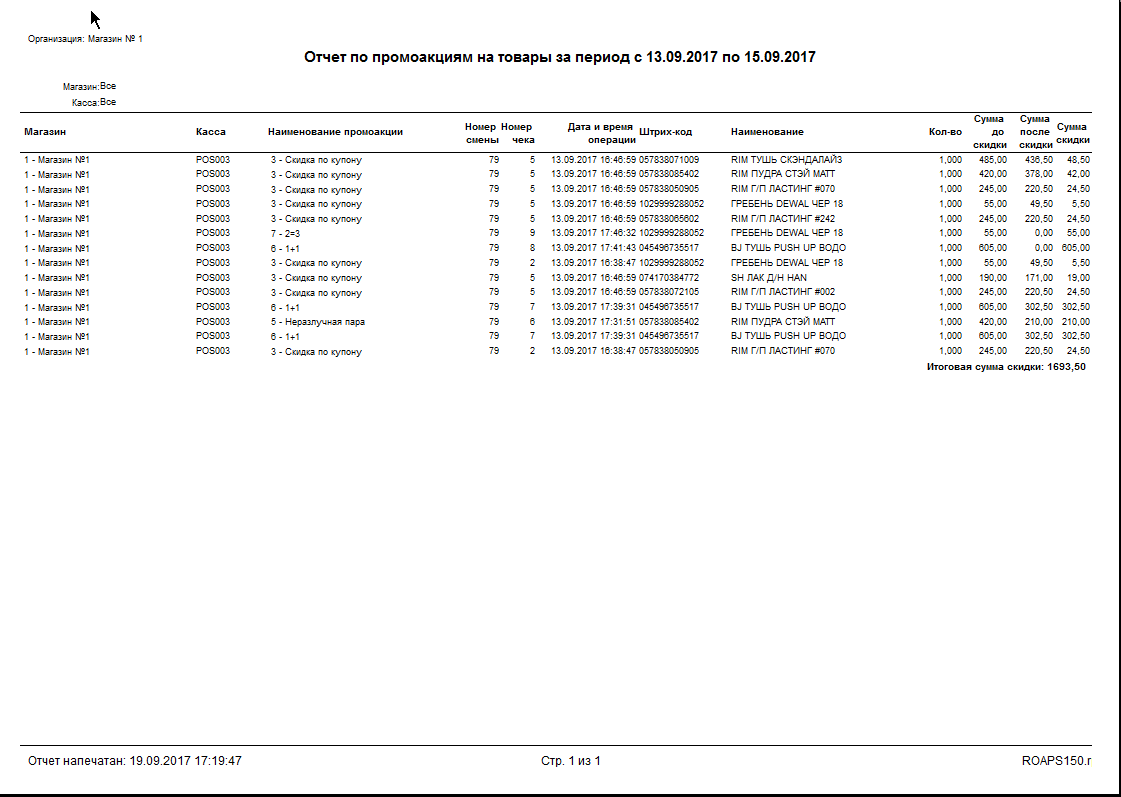Promo in check: How to build a loyalty program for the store without high costs

The loyalty program is a handy tool that allows retailers to attract and retain customers. However, it is difficult to choose the one that will be effective for a particular store. We tell how to carry out a primary research of consumer preferences with the help of promotions and save a lot of money.
Today in Russia, stores almost always choose between two types of loyalty programs: bonus and discount. The first implies a delayed benefit for the buyer, the second gives him an instant discount. By the way, a little secret: it is more profitable for shops to use the bonus program. With its help it is easier to keep the customer: he is motivated to come back to the store for profit. Of course, buyers are often more interested in a discount program: it’s easier to immediately get a discount on a product than to save and then subsequently use points. But it's not about that.
The implementation of any of these loyalty programs is associated with serious investments. First, you need a special software. Secondly, it is necessary to spend money on issuing plastic cards. We keep silent about the fact that customers are already frankly tired of the endless plastic that they are trying to sell in every store.
')
And so it turns out that the conventional electronics store has spent a lot of money on the introduction of a discount loyalty program and issuing plastic cards. And then by trial and error I found out that it is more profitable for him to use the bonus one. This is because a lot of factors affect, for example, the geographical location of the store, its proximity to competitors, the relevance of the shares held. As a result, we need new spending on changing loyalty programs and reissuing cards. Nicely? We do not think.
Promo on check
Do not fall into this trap can be practiced on the cats: roughly testing the promotions that can be run using the discount and bonus loyalty programs. But by doing this at the expense of a system of well-planned promotions.
Today, many front-office systems allow retailers to launch promotions that determine the use of discounts or other effects on the purchase, issued at the checkout without using discount or bonus cards.
For example, in the cash software Profi-T, Promo-Server is responsible for this task - the designer of promotions. With its help, the marketer can easily create promotions, the condition for triggering which will not be the presentation of a discount or bonus card by the buyer, but the purchase of certain goods (from a promo list, promotional group) or a discount coupon (including a unique one from the check). In addition, a “Report on promotions for goods for the period” is available, which makes it easy to determine the popular promotions and the amount of discounts provided to customers within each of them. Thus, by analyzing the information received, you can plan a complete loyalty system.
So, conditionally all promotions are divided into two categories:
- aimed at increasing the average check (discount on a set of goods, N + N, inseparable pair, a gift for the purchase);
- aimed at retaining customers (discount coupon, promotional text containing a calendar of discounts).
The task of the front-office system is not only to ensure the processing of requests from cash desks for application to the executed purchases of certain promotions, but also to correctly distribute the resulting discount between the goods and clearly reflect it in the check. That is, to issue it in such a way that the buyer had no questions, for what and what kind of discount he received. Accordingly, the front-office system should, when applying a discount, calculate the correct value of the goods, determine the amount of the discount and indicate it on the receipt.
What does this look like? By the way, we immediately note that any check consists of mandatory information and additional data that can be edited at the request of the retailer to visually tell customers about the planned promotions.
Shares aimed at increasing the average check
The most common and effective actions aimed at increasing the average check can be called:
- N + N promotion encourages the buyer to purchase goods for the future at a reduced price. For example, 1 + 1 - two products for the price of one - implies a 50% discount on the product;

- discount on a set of goods - the buyer receives a discount / gift when buying a certain set of goods. For example, if you buy a pencil and pen from a certain manufacturer, then its eraser is ready to give to you free of charge. Or, he will give you a toy as a gift if you bought children's clothes for 2000 rubles;

In our example, when purchasing a set of products "three for the price of two" - two nail polishes - the buyer receives a hair comb as a gift. In the check it goes at zero price.
- an inseparable pair is a fixed set of goods, with the purchase of which one (for example, with the lowest cost) will be discounted for the buyer.

In this example, powder and mascara are used as an “inseparable pair” - for powder, as for a product with a lower cost, the buyer receives a 50% discount.
- gift for purchase - when purchasing certain goods, the buyer receives a gift at the checkout. The receipt may contain an advertising text telling about the benefit available to it. For example, notifying him that when purchasing a certain group of goods, he will be able to count on a gift. In addition, on the cash register software, you can display a reminder for the cashier so that he does not forget to give the gift to the buyer.

In this example, a receipt is displayed on the receipt for the buyer about receiving a gift for the purchase - Safeguard soap at the checkout. The message about the gift is duplicated on the monitor to the cashier when going to the settlement part of the check.
The front-office system needs to analyze the commodity part of the check, determine the floating discount and distribute it among the goods. And then visually check in the check, indicating the value of the goods before, after applying the discount and the total discount on the check.
Note, the discount can be distributed proportionally between all the goods in the check, or apply it to one product, indicating that it is sold at zero price (shown in the illustration). At the same time, according to the law, it is impossible to do this, but retailers periodically go for such violations.

Shares aimed at retaining customers
It is important not only to increase the size of the check, but also to tie the buyer to the store. Therefore, you can specify in the check information aimed at retaining customers.
The most common and effective measures aimed at retaining customers include:
- coupon promotion;
- promotional text containing a calendar of discounts.
A coupon promotion consists of two mandatory steps: printing a coupon and applying it (percentage or absolute discount). Intervals of the action may be different: for example, today we print a coupon, and tomorrow we apply a discount. Either all week on weekdays we print coupons, and on weekends we use them. Also, the retailer can indicate the dependence of the coupon (discount amount) on the amount of the purchase made. For example, in a check for 500 rubles a coupon for a discount of 5% is displayed, with 1000 rubles - by 10%. The unique coupon is formed dynamically by the front-office system and contains information about the numbers of the promotion, shop, ticket office, cash register shift and coupon inside the check. It is used once.

For example, the buyer receives a coupon for 10% discount on the purchase amount, valid from September 1 to September 30.

In this example, the buyer used the coupon provided to him for a 10% discount. As part of the same check, he received a new coupon for the next purchase.
However, the front-office system may allow the retailer to create non-unique coupons that can be used by anyone. Thus, the "Promo Server" allows you to generate a barcode in the image format, which can then be used in advertising leaflets or leaflets.
Another important opportunity to attract customers is the discount calendar. If the retailer plans, for example, to conduct certain promotions for some goods during the week, then you can notify them in the check. Thus, the buyer will know for sure that, for example, if he, having entered the store from September 15 to September 30, is able to count on a 20% discount on shower gels.

It is important that the front-office system allows not only to carry out promotions, but also to analyze their results. After all, the subsequent choice of the loyalty program directly depends on this. For example, our "Promo-Server" generates reports showing which stocks were the most popular: how many times they worked in the store and how many they used. In addition, it helps to control the total discount level: that is, to set a certain threshold so that the product participating in several promotions does not exceed it and the store does not go to minus.

Source: https://habr.com/ru/post/338302/
All Articles